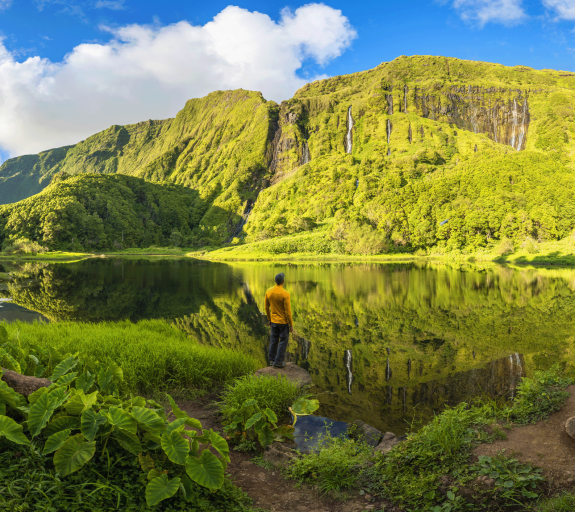
Why investing in biodiversity means looking at the solutions, not just the problems
- 17 April 2023 (5 min read)
Key points:
- Investors looking to make a positive impact on biodiversity preservation might consider directing capital towards companies providing solutions to the crisis
- There are a myriad of innovative technologies, processes, and approaches in development across sectors helping companies lessen their impact on the environment, biodiversity in particular
- We see potential opportunities in several sectors including agriculture, water treatment, and sustainable materials
Over half the value of the global economy – some $44trn – is potentially threatened by the loss of nature. 1 However, there is a significant shortfall in the value of current investments targeted at protecting Earth’s biodiversity.
About $133bn is invested annually in nature-based solutions – including $18bn from private sector finance – but this needs to at least triple by 2030 if the world is to meet its climate targets.2
So, it’s unsurprising that protecting Earth’s ecosystems and the natural world is increasingly part of investors’ objectives as they consider leveraging their financial capabilities to address this environmental crisis.
As well as investing through an environmental, social, and governance (ESG) lens – biodiversity especially – we believe there are ways in which investors may make a positive impact on biodiversity preservation. Directing capital towards companies providing the solutions to this crisis is one potential avenue.
Rather than purely favoring companies with a limited biodiversity footprint, and perhaps a limited reach beyond their own operations, we believe there is potential value in identifying firms producing goods and services which can have a positive benefit on biodiversity preservation on a wider scale.
Here, we focus on three areas – agriculture and aquaculture, water treatment, and sustainable materials – where we see companies playing a role in biodiversity preservation, providing potential opportunities for investors.
Tech-driven agriculture
Climate change, the COVID-19 pandemic, and the Ukraine war have contributed to a growing food crisis. Global food supplies are expected to fall to a three-year low in 2022-2023, while 349 million people across 79 countries are classed as “acutely food insecure.”3 The world must find ways to increase crop yield and protect harvests from diseases without increasing pollution or the use of pesticides with potentially harmful effects.
New technologies are helping food producers reduce their biodiversity impact while improving productivity – such as Deere’s precision agriculture systems that can plant, fertilize, and treat crops more efficiently than conventional planters and sprayers. 4 These systems reduce the amount of fertilizer needed and the risk of run-off and eutrophication – i.e., the increased nutrients in water deplete oxygen, harmful to biodiversity – while also lowering costs.
Companies operating in this space will need to align with new regulations – such as the European Union’s target for a 50% reduction in the use of chemical pesticides by 20305 – which has the potential to create more opportunities for investors.
Alongside agriculture is aquaculture –breeding fish as food –which is increasingly recognized as a key part of global food supplies and nutrition. But more than a third (35.4%) of the world’s fish stocks are over-fished impacting both food security and biodiversity.6
Fish is a key source of omega-3, an important nutrient, and one also used in fish farming as a food for bigger fish such as salmon. One solution to diminishing stocks is creating plant-based omega-3 – from algae rather than from fish – which companies like Corbion are doing as a sustainable alternative to reduce pressure on marine resources.7
Smart water use and treatment
When it comes to water, there is no substitute for this life-sustaining commodity. It’s common knowledge that water covers 75% of the Earth’s surface, leading people to believe it’s an infinite resource. However, just 3% of the Earth’s water is fresh water, and two-thirds of that is unavailable for human use – for example quantities in the form of frozen glaciers. Some 2.7 billion people face water scarcity at least some of the year, and 2.4 billion lack adequate sanitation.8
Water treatment, including filtration and purification, is therefore crucial. Companies we believe are at the forefront of this industry harness artificial intelligence and digitalization to provide solutions for their customers, helping them limit their biodiversity impact. Innovations of this nature include Evoqua’s smart water system enabling remote monitoring and analytics. The biogas produced during its wastewater treatment method creates enough renewable energy to power approximately 5,000 homes a day.9
There are also growing opportunities in water meter systems, which can help optimize and reduce usage. Investors may find opportunities in new technologies as the water sector undergoes a digital transformation – as demonstrated by solutions such as Xylem’s software and analytics to help water and wastewater companies tackle challenges in a more sustainable way.10
Innovations in sustainable packaging
The third area where we see companies contribute to biodiversity preservation through their products and solutions is sustainable materials, such as food and drink packaging (e.g., aluminium cans).
While the process of mining for the metal does, of course, have an impact on biodiversity, almost 70% of all aluminium cans produced globally are recycled –the metal infinitely recyclable. A market leader for aluminium cans, Ball, says the timeframe from a customer purchasing a canned drink to the aluminium in that same can appearing again on the retailer’s shelf can be as little as 60 days.11
Paper and packaging companies are also seeking to use more recycled materials to replace less sustainable alternatives. Of course, trees must be felled to provide the input for paper manufacturing, but this can come from sustainably managed forests where more trees are grown than harvested each year. Companies can also use land with low biodiversity value to source and replenish lumber stock, such as former pastureland. This is one approach Finnish packaging company Stora Enso has adopted whose forests are a net carbon sink. Its products include wood-based trays that can be used for microwave meals instead of plastic, reducing carbon dioxide emissions by up to two-thirds.12
Sustainable materials are not just all about packaging. The fashion industry is responsible for as much as 10% of global carbon emissions, and we are already seeing a raft of innovations here driving greater sustainability.13 Companies like Lenzing are developing more efficient textile production methods with lower impacts on the environment and which help protect biodiversity. One method Lenzing employs uses unconventional raw materials such as orange pulp to make fibers. of the company is also developing new methods for embedding color pigment during fiber production, meaning materials do not need to be dyed – a process that normally contributes significantly to water pollution.14
Investing for a more sustainable future
There is no doubt that society places significant strain on the world’s ecosystems, and this will likely continue as populations continue growing and living standards increase. But to protect biodiversity and slow its decline, we believe we need to identify, and invest in, the solutions that can be leveraged to lower our biodiversity footprint in a more efficient, more sustainable way.
There are a plethora of innovative technologies, processes, and approaches being developed across sectors, which enable companies to lessen their impact on the environment and protect against biodiversity loss. We have highlighted just a small number, but we see potential opportunities across the equity spectrum for investors wanting to build a biodiversity-focused investment strategy.
References to companies are for illustrative purposes only and should not be viewed as investment recommendations.
- PGEgaHJlZj0iaHR0cHM6Ly93d3czLndlZm9ydW0ub3JnL2RvY3MvV0VGX1RoZV9GdXR1cmVfT2ZfTmF0dXJlX0FuZF9CdXNpbmVzc18yMDIwLnBkZiI+V29ybGQgRWNvbm9taWMgRm9ydW0gKFdFRikgKDA3LzE0LzIwMjApOiBUaGUgRnV0dXJlIE9mIE5hdHVyZSBBbmQgQnVzaW5lc3M8L2E+
- PGEgaHJlZj0iaHR0cHM6Ly93d3cudW5lcC5vcmcvcmVzb3VyY2VzL3N0YXRlLWZpbmFuY2UtbmF0dXJlIj5VTiBFbnZpcm9ubWVudCBQcm9ncmFtIChVTkVQKSwgV0VGLCBFbnZpcm9ubWVudCBMaWFiaWxpdHkgRGlyZWN0aXZlIChFTEQpLCBWaXZpZCBFY29ub21pY3MgKDA1LzI3LzIwMjEpOiBTdGF0ZSBvZiBGaW5hbmNlIGZvciBOYXR1cmU8L2E+
- PGEgaHJlZj0iaHR0cHM6Ly93d3cuZmFvLm9yZy9uZXdzcm9vbS9kZXRhaWwvam9pbnQtc3RhdGVtZW50LWJ5LXRoZS1oZWFkcy1vZi1mYW8taW1mLXdvcmxkLWJhbmstd2ZwLWFuZC13dG8vZW4iPkZvb2QgYW5kIEFncmljdWx0dXJlIE9yZ2FuaXphdGlvbiAoRkFPKSAoMDIvMDgvMjAyMyk6IEpvaW50IFN0YXRlbWVudCBieSB0aGUgaGVhZHMgb2YgRkFPLCBJTUYsIFdvcmxkIEJhbmssIFdGUCBhbmQgV1RPIDwvYT4=
- PGEgaHJlZj0iaHR0cHM6Ly93d3cucHJuZXdzd2lyZS5jb20vbmV3cy1yZWxlYXNlcy9qb2huLWRlZXJlLWRlYnV0cy1uZXctcGxhbnRpbmctdGVjaG5vbG9neS0tZWxlY3RyaWMtZXhjYXZhdG9yLWR1cmluZy1jZXMtMjAyMy1rZXlub3RlLTMwMTcxNDY2NS5odG1sIj5EZWVyZSAmYW1wOyBDb21wYW55ICgwMS8wNS8yMDIzKTogSm9obiBEZWVyZSBEZWJ1dHMgTmV3IFBsYW50aW5nIFRlY2hub2xvZ3kgJmFtcDsgRWxlY3RyaWMgRXhjYXZhdG9yIER1cmluZyBDRVMgMjAyMyBLZXlub3RlPC9hPg==
- PGEgaHJlZj0iaHR0cHM6Ly9lYy5ldXJvcGEuZXUvY29tbWlzc2lvbi9wcmVzc2Nvcm5lci9kZXRhaWwvZW4vcWFuZGFfMjJfMzY5NCI+RXVyb3BlYW4gQ29tbWlzc2lvbiAoMDYvMjIvMjAyMik6IEZhcm0gdG8gRm9yazogTmV3IHJ1bGVzIHRvIHJlZHVjZSB0aGUgcmlzayBhbmQgdXNlIG9mIHBlc3RpY2lkZXMgaW4gdGhlIEVVPC9hPg==
- PGEgaHJlZj0iaHR0cHM6Ly93d3cubXNjLm9yZy93aGF0LXdlLWFyZS1kb2luZy9vY2VhbnMtYXQtcmlzay9iaW9kaXZlcnNpdHktYW5kLWZpc2hpbmciPk1hcmluZSBTdGV3YXJkc2hpcCBDb3VuY2lsIChuLmQuKTogQmlvZGl2ZXJzaXR5IGFuZCBmaXNoaW5nPC9hPg==
- PGEgaHJlZj0iaHR0cHM6Ly93d3cuY29yYmlvbi5jb20vZW4vUHJvZHVjdHMvQWxnYWUtaW5ncmVkaWVudHMtcHJvZHVjdHMvQWxnYVByaW1lREhBIj5Db3JiaW9uIChuLmQuKTogQWxnYVByaW1l4oSiIERIQTogdGhlIHN1c3RhaW5hYmxlIG9tZWdhLTMgc29sdXRpb248L2E+
- PGEgaHJlZj0iaHR0cHM6Ly93d3cud29ybGR3aWxkbGlmZS5vcmcvdGhyZWF0cy93YXRlci1zY2FyY2l0eSI+V29ybGQgV2lsZGxpZmUgRnVuZCAoV1dGKSAobi5kLik6IFRocmVhdHMgLSBXYXRlciBTY2FyY2l0eTwvYT4=
- PGEgaHJlZj0iaHR0cHM6Ly93d3cuZXZvcXVhLmNvbS9lbi9ldm9xdWEvcHJvZHVjdHMtLXNlcnZpY2VzL2RpZ2l0YWwtd2F0ZXIvd2F0ZXItb25lLXNlcnZpY2VzL3NvcGhpcy1kaWdpdGFsLXNlcnZpY2VzLWEtd2F0ZXItb25lLXNvbHV0aW9uLyI+RXZvcXVhIChuLmQuKTogU29waGlz4oSiIERpZ2l0YWwgU2VydmljZXM6IEEgV2F0ZXIgT25lwq4gU29sdXRpb24gLyAoMDMvMjIvMjAxOSk6IFdvcmxkIFdhdGVyIERheSBJbmZvZ3JhcGhpYzwvYT4=
- PGEgaHJlZj0iaHR0cHM6Ly93d3cueHlsZW0uY29tL2VuLXVzL21ha2luZy13YXZlcy93YXRlci11dGlsaXRpZXMtbmV3cy94eWxlbS1hbmQtaWRyaWNhLXBhcnRuZXItdG8tYWNjZWxlcmF0ZS1kaWdpdGFsLXRyYW5zZm9ybWF0aW9uLW9mLXdhdGVyLXV0aWxpdGllcy8iPiBYeWxlbSAoMDEvMTEvMjAyMyk6IFh5bGVtIGFuZCBJZHJpY2EgUGFydG5lciBUbyBBY2NlbGVyYXRlIERpZ2l0YWwgVHJhbnNmb3JtYXRpb24gT2YgV2F0ZXIgVXRpbGl0aWVzPC9hPg==
- e0JhbGwgKG4uZC4pOiBSZWFsIENpcmN1bGFyaXR5O2h0dHBzOi8vd3d3LmJhbGwuY29tL3N1c3RhaW5hYmlsaXR5L3JlYWwtY2lyY3VsYXJpdHl9
- PGEgaHJlZj0iaHR0cHM6Ly93d3cuc3RvcmFlbnNvLmNvbS8tL21lZGlhL2RvY3VtZW50cy9kb3dubG9hZC1jZW50ZXIvZG9jdW1lbnRzL2FubnVhbC1yZXBvcnRzLzIwMjIvc3RvcmFlbnNvX2FubnVhbF9yZXBvcnRfMjAyMi5hc2h4Ij5TdG9yYSBFbnNvICgwMi8xNC8yMDIzKTogQW5udWFsIFJlcG9ydCAyMDIyIC8gKG4uZC4pOiBUcmF5Zm9ybWEgLSBCYXJyaWVyIGJvYXJkczwvYT4=
- PGEgaHJlZj0iaHR0cHM6Ly93d3cud29ybGRiYW5rLm9yZy9lbi9uZXdzL2ZlYXR1cmUvMjAxOS8wOS8yMy9jb3N0by1tb2RhLW1lZGlvLWFtYmllbnRlIj5Xb3JsZCBCYW5rOiBIb3cgTXVjaCBEbyBPdXIgV2FyZHJvYmVzIENvc3QgdG8gdGhlIEVudmlyb25tZW50PzwvYT4=
- PGEgaHJlZj0iaHR0cHM6Ly93d3cubGVuemluZy5jb20vbmV3c3Jvb20vcHJlc3MtcmVsZWFzZXMvcHJlc3MtcmVsZWFzZS9sZW56aW5nLWNvbGxhYm9yYXRlcy13aXRoLW9yYW5nZS1maWJlci1hcy1wYXJ0LW9mLW5ldy10ZW5jZWx0bS1saW1pdGVkLWVkaXRpb24taW5pdGlhdGl2ZSI+TGVuemluZyAoMDcvMTQvMjAyMSk6IExlbnppbmcgY29sbGFib3JhdGVzIHdpdGggT3JhbmdlIEZpYmVyIGFzIHBhcnQgb2YgbmV3IFRFTkNFTOKEoiBMaW1pdGVkIEVkaXRpb24gaW5pdGlhdGl2ZTwvYT4gLyB7O2h0dHBzOi8vd3d3LnRlbmNlbC5jb20vYjJiL25ld3MtYW5kLWV2ZW50cy90ZW5jZWwtaW50cm9kdWNlcy1wZXJmb3JtYW5jZS1mYWJyaWMtd2l0aC0xMDAtY2VsbHVsb3NlLWZpYmVyc1RlbmNlbCAoMDgvMTIvMjAyMSk6IFRFTkNFTOKEoiBpbnRyb2R1Y2VzIHBlcmZvcm1hbmNlIGZhYnJpYyB3aXRoIDEwMCUgY2VsbHVsb3NlIGZpYmVyc30=
Read more on Biodiversity
Disclaimer
Not for Retail distribution: this document is intended exclusively for Professional, Institutional, Qualified or Wholesale Investors / Clients, as defined by applicable local laws and regulation. Circulation must be restricted accordingly.
This document is being provided for informational purposes only. The information contained herein is confidential and is intended solely for the person to which it has been delivered. It may not be reproduced or transmitted, in whole or in part, by any means, to third parties without the prior consent of the AXA Investment Managers, Inc. (the “Adviser”). This communication does not constitute on the part of AXA Investment Managers a solicitation or investment, legal or tax advice. Due to its simplification, this document is partial and opinions, estimates and forecasts herein are subjective and subject to change without notice. There is no guarantee forecasts made will come to pass. Data, figures, declarations, analysis, predictions and other information in this document is provided based on our state of knowledge at the time of creation of this document. Whilst every care is taken, no representation or warranty (including liability towards third parties), express or implied, is made as to the accuracy, reliability or completeness of the information contained herein. Reliance upon information in this material is at the sole discretion of the recipient. This material does not contain sufficient information to support an investment decision.
© 2023 AXA Investment Managers. All rights reserved

